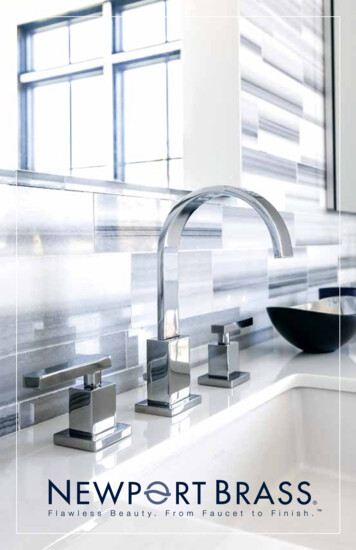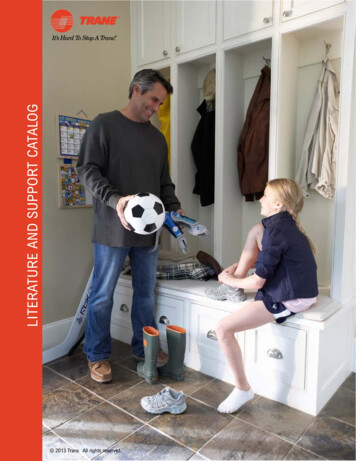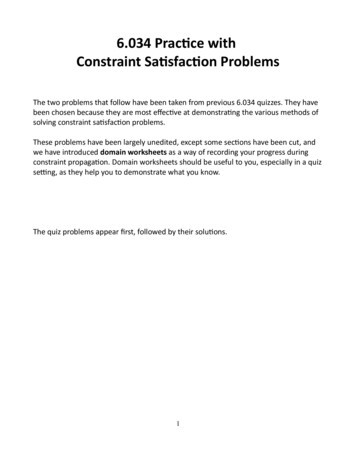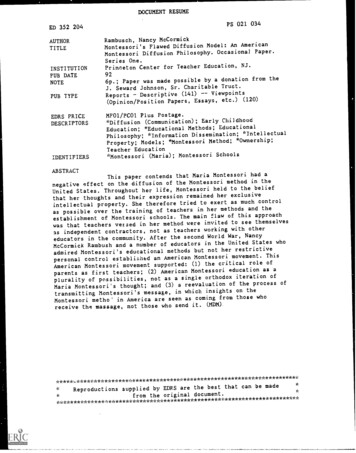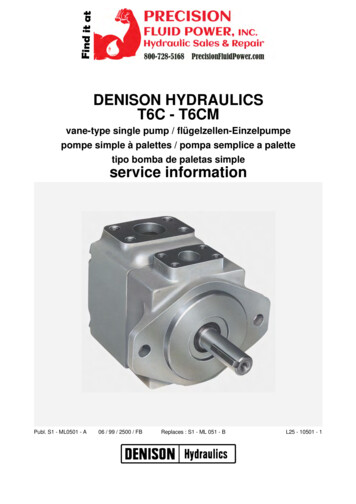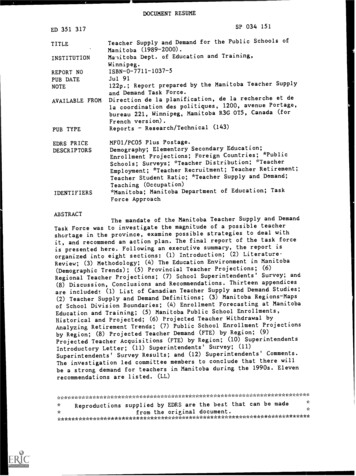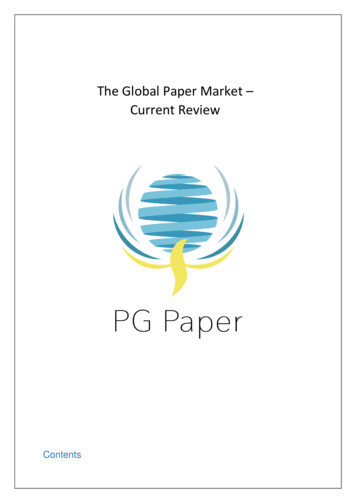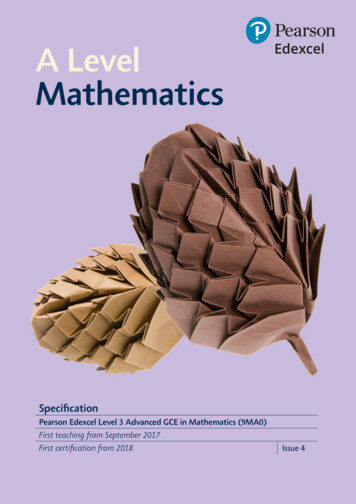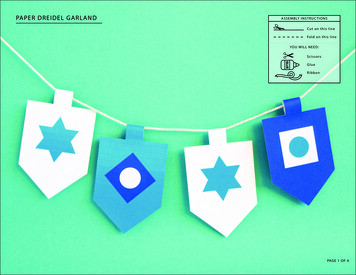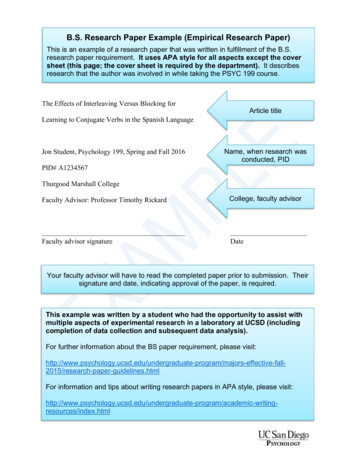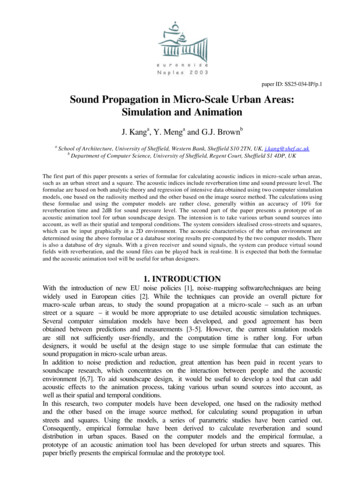
Transcription
paper ID: SS25-034-IP/p.1Sound Propagation in Micro-Scale Urban Areas:Simulation and AnimationJ. Kanga, Y. Menga and G.J. BrownbaSchool of Architecture, University of Sheffield, Western Bank, Sheffield S10 2TN, UK, j.kang@shef.ac.ukbDepartment of Computer Science, University of Sheffield, Regent Court, Sheffield S1 4DP, UKThe first part of this paper presents a series of formulae for calculating acoustic indices in micro-scale urban areas,such as an urban street and a square. The acoustic indices include reverberation time and sound pressure level. Theformulae are based on both analytic theory and regression of intensive data obtained using two computer simulationmodels, one based on the radiosity method and the other based on the image source method. The calculations usingthese formulae and using the computer models are rather close, generally within an accuracy of 10% forreverberation time and 2dB for sound pressure level. The second part of the paper presents a prototype of anacoustic animation tool for urban soundscape design. The intension is to take various urban sound sources intoaccount, as well as their spatial and temporal conditions. The system considers idealised cross-streets and squares,which can be input graphically in a 2D environment. The acoustic characteristics of the urban environment aredetermined using the above formulae or a database storing results pre-computed by the two computer models. Thereis also a database of dry signals. With a given receiver and sound signals, the system can produce virtual soundfields with reverberation, and the sound files can be played back in real-time. It is expected that both the formulaeand the acoustic animation tool will be useful for urban designers.1. INTRODUCTIONWith the introduction of new EU noise policies [1], noise-mapping software/techniques are beingwidely used in European cities [2]. While the techniques can provide an overall picture formacro-scale urban areas, to study the sound propagation at a micro-scale – such as an urbanstreet or a square – it would be more appropriate to use detailed acoustic simulation techniques.Several computer simulation models have been developed, and good agreement has beenobtained between predictions and measurements [3-5]. However, the current simulation modelsare still not sufficiently user-friendly, and the computation time is rather long. For urbandesigners, it would be useful at the design stage to use simple formulae that can estimate thesound propagation in micro-scale urban areas.In addition to noise prediction and reduction, great attention has been paid in recent years tosoundscape research, which concentrates on the interaction between people and the acousticenvironment [6,7]. To aid soundscape design, it would be useful to develop a tool that can addacoustic effects to the animation process, taking various urban sound sources into account, aswell as their spatial and temporal conditions.In this research, two computer models have been developed, one based on the radiosity methodand the other based on the image source method, for calculating sound propagation in urbanstreets and squares. Using the models, a series of parametric studies have been carried out.Consequently, empirical formulae have been derived to calculate reverberation and sounddistribution in urban spaces. Based on the computer models and the empirical formulae, aprototype of an acoustic animation tool has been developed for urban streets and squares. Thispaper briefly presents the empirical formulae and the prototype tool.
paper ID: SS25-034-IP/p.22. SIMULATION AND FORMULAEA series of formulae have been developed for calculating the reverberation time (RT), earlydecay time (EDT) and sound pressure level (SPL), under various boundary conditions. Thispaper, for the sake of brevity, only presents the formulae for urban squares with diffuselyreflecting boundaries.The formulae are related to the computer model based on the radiosity method. In the model,each urban boundary is divided into a number of small patches, and the sound propagation in anurban area is simulated by the energy exchange between patches [8-11]. The model calculatesimpulse responses, from which various acoustic indices can be derived, including RT, EDT andSPL. Using the model, a series of parametric studies have been carried out with a wide range ofurban square configurations: length L 20-200m, width W 20-200m, height H 5-100m, andsquare area 400-40000m2 . The length/width ratio is 1:1 to 4:1, and the side/height ratioLW / H is 0.5-40. Buildings are considered to be along two, three or four sides of a square,with an absorption coefficient of 0.1-0.9.It has been shown that with diffusely reflecting boundaries, for an urban square surrounded bybuildings with low side/height ratio and low boundary absorption coefficient, the average RT30using the radiosity simulation is very close to that calculated by the well-known Eyring formula.However, with the increase of side/height ratio and boundary absorption the Eyring formulabecomes increasingly inaccurate. Based on theoretical analysis and regression of simulationresults, several correction items are introduced. The final form of the reverberation formula is:RT 30 0.16V SLn(1 α ) 4 mV( 88.6 49α b 2.7LW)H(1) where S is the total surface area and α is the average absorption coefficient, both including animaginary square ceiling. V LWH , m is the air absorption factor, and α b is the averageabsorption coefficient of boundaries, i.e. façades and ground only. It has been demonstrated thatwithin the configuration range considered, calculations by equation (1) and by the radiositymodel are very close, generally within an accuracy of 10-15%.With a similar procedure as above, a formula for the SPL distribution in a square with diffuselyreflecting boundaries has also been derived:L LW 10 log( Q3H 4 )24πrW L R(2)where R Sα T /(1 α T ) and α T α 4mV / S . LW is the sound power level of the source, Q isthe directivity factor of the source, and r is the source-receiver distance. The difference betweencalculations using equation (2) and using the radiosity model is generally within 2dB. Equation(2) is inapplicable to long rectangular spaces, where the SPL attenuation is considerably greaterthan that in quasi-square spaces.
paper ID: SS25-034-IP/p.33. DIGITAL AUDIO ANIMATIONTo develop a digital audio animation tool for aiding the design process of urban soundscape, thebasic requirements include: (1) It should consider various urban sound sources, such as traffic,fountains, street music, construction, human voice and bird singing; (2) It should considerdynamic characteristics of the sources, for example, variation of traffic in a weekday; (3) Itshould consider the movements of sources and receivers; and (4) The calculation speed shouldbe reasonably fast, so that a designer can adjust the design and then listen to the difference.Existing software, however, is not directly applicable to the above. Programs based ontechniques for room acoustics simulation, although producing rather accurate acoustic indicesand providing good auralization functions, are time-consuming and less suitable for consideringmultiple sources with dynamic characteristics. Some noise-mapping programs can provideacoustic animations, but reverberation is normally not considered, and the source conditions arestill rather simple. In the virtual reality sector, digital sound rendering techniques are beingrapidly developed, but the space configurations and the sound source situations are ratherdifferent from those required in urban soundscape. As a result, to aid urban soundscape design, itis still necessary to develop a simple but practical tool.In this research such a tool is being developed, where the early part of impulse responses can besimulated by techniques such as ray-tracing, and the late decays are determined using formulaesuch as those presented in Section 2, or using a database. In the database the results are precomputed using simulation models such as those mentioned in Section 2. In this way, the sourcelocation and the spatial effects can be reasonably well simulated, but the calculation time isgreatly reduced. In the following sections, a prototype of such a tool is briefly presented.3.1. The systemThe prototype has been developed using Java, an object-oriented programming language.Currently it is for idealised cross-streets and squares, and the reverberation effect is based on theRT rather than simulated impulse responses. The interface of design input is shown in Figure 1.It allows the user to input a design graphically in a 2D environment. Within an area of 200m by200m, a wide range of street and square dimensions can be given. Buildings are assumed to becontinuous along a street or along two or more sides of a square, and of a constant height.Any number of sources can be selected from a database, which currently includes 20 dry soundsamples in .wav, .au or .aiff format. The sources can be put at any position in the streets or thesquare. There is no limitation for the signal length.For a given receiver, the system can determine the acoustic indices including RT, EDT and SPLbased on a database or formulae, as described in Section 3.2. The system can then produce soundfiles with appropriate sound level and reverberation, based on the digital audio processingdescribed in Section 3.3. Figure 2 shows the interface for inputting sources and receivers, as wellas generating sound files. The calculation and convolution are rather fast – a sound file can beplayed back immediately after a receiver is given. The original dry signals without the effects ofurban environment can also be played back for comparison.The system is intended to be user-friendly and great attention has been paid to user interaction. Adesigner can change the configuration, and then listen to the acoustic environment in real-time.A design can be saved for further comparison and presentation. In the system a help function andsome initial design guidelines for urban soundscape are also included.
paper ID: SS25-034-IP/p.4Figure 1. Interface for design input in the prototype tool for aiding soundscape design.Figure 2. Interface for inputting sources and receivers and generating sound files.
paper ID: SS25-034-IP/p.53.2. DatabaseFor urban streets, a database has been created to store pre-computed acoustic indices, includingRT, EDT and SPL. The database is based on simulations using the radiosity model and the imagesource model as mentioned previously. For urban squares, direct calculation can be made usingthe simplified formulae as partly presented in Section 2. In the database both diffusely andgeometrically reflecting boundaries are considered. Currently the boundary absorptioncoefficient is assumed to be 0.1 and no air absorption is taken into account.In the current database the range of street dimensions are: length, 10-200m; width, 5-60m, andheight 3-16m. For squares the dimensions correspond to the applicable range of the formulae(see Section 2). The database is still being expanded by considering more configurations andmore boundary conditions.3.3. Digital audio processingThe system renders user selected dry sound signals with the acoustic indices, to simulate thereverberation effects. Conventionally digital audio processing could only be implemented usingspecial digital signal processing (DSP) hardware because of the limitation in computingresources, but the Java sound application programming interface (API) specifies mechanisms forcapturing, processing, and playing back audio data in a framework that promotes extensibilityand flexibility [12]. It allows full access to the underlying synthesis and the rendering enginewithout much complicated digital processing code.A set of unit generators form an audio processing chain (including the special unit thatcommunicates with the audio hardware), allowing the system to read, render and play soundfiles. These generators, which have been implemented using the Java sound API, encapsulate theuse of audio processing at the signal level. The source unit reads the dry signal as a .wav, .au or.aiff file and passes it to the reverb unit. The reverb unit renders the sound via audio-buffers andthe sink unit converts those back into audio files.In this prototype, the implementation of the reverb unit is based on the reverberation algorithmsoriginally developed by Moorer [13-14]. The input signal is filtered through 6 parallel combfilters with a lowpass filter in each loop. Each comb filter is characterised by a feedbackcoefficient and a delay time, which are related to the space size and the RT. The result ofsumming the 6 comb filter outputs is fed through two allpass filters, which are againcharacterised by a feedback coefficient and a loop delay time. The final result is then mixed withthe original dry signal.3.4. Discussion and further workThe tool is still in its initial stage, and substantial development is being carried out. Variousdigital audio animation methods, from computing full impulse responses to considering a singleRT, will be compared through subjective listening tests in a CAVE environment [15], in order todetermine a fast but appropriate method. Head-related functions are being integrated to generatevirtual acoustic environments with a better spatial impression. More state-of-the-art techniquesin virtual reality are also being integrated [16]. General configurations of micro-scale urban areaswill be considered in 3D, with the possibility of inputting drawing files from a range of programscommonly used in architectural and urban design. More spatial and dynamic characteristics ofthe urban sound sources are also being incorporated.
paper ID: SS25-034-IP/p.64. CONCLUSIONSThis paper briefly presents the empirical formulae for calculating sound field in micro-scaleurban areas like an urban square, and a prototype of an acoustic animation tool for aiding urbansoundscape design. The formulae are easy to use and the calculations using these formulae andusing the computer simulation models are very close, generally within an accuracy of 10% forreverberation time and 2dB for sound pressure level. The prototype simplifies the simulationprocess by using a database or the formulae. With a given receiver and dry sound signals, thesystem can produce virtual sound fields with reverberation in real-time. While the prototype hasbeen proven to be useful for aiding design, substantial further developed is still being carried out.ACKNOWLEDGEMENTSThis research is a part of Key Action 4 "City of Tomorrow and Cultural Heritage" from theprogramme "Energy, Environment and Sustainable Development" within the Fifth FrameworkProgramme of the European .14.15.16.The European Commission, Proposal for a Directive of the European Parliament and of the CouncilRelating to the Assessment and Management of Environmental Noise, 2000.Schal International Management Limited, Noise Mapping England, London, 2002.D. J. Oldham and M. M. Radwan, Sound Propagation in City Streets, Building Acoustics 1, pp.65-87,(1994).J. Picaut, L. Simon and J. Hardy, Sound Field Modelling in Streets with a Diffusion Equation, J. Acoust.Soc. Am. 106, pp.2638-2645, (1999).J. Kang, Numerical Modelling of the Sound Field in Urban Streets with Diffusely Reflecting Boundaries, J.Sound Vib. 258 (5), pp.793-813, (2002).B. Berglund, C.A. Eriksen and M.E. Nilsson, “Perceptual characterization of soundscapes in residentialareas”, Proceedings of the 17th International Congress on Acoustics (ICA), Rome, 2001.J. Kang and M. Zhang, Semantic Differential Analysis on the Soundscape of Urban Open Public Spaces, J.Acoust. Soc. Am. 112, pp.2435, (2002).J. Kang, Acoustics of Long Spaces: Theory and Design Guide, Thomas Telford Publishing, London, 2002.J. Kang, Reverberation in Rectangular Long Enclosures with Diffusely Reflecting Boundaries,Acustica/acta acustica 88, pp.77-87, (2002).J. Kang, Sound Propagation in Interconnected Urban Streets: A Parametric Study, Environment andPlanning B: Planning and Design 28, pp.281-294, (2001).J. Kang, Sound Propagation in Street Canyons: Comparison between Diffusely and GeometricallyReflecting Boundaries, J. Acoust. Soc. Am. 107, pp.1394-1404, (2000).Sun Microsystems Inc, http://java.sun.com/products/java-media/sound/.M. Kahrs , Applications of Digital Signal Processing to Audio and Acoustics, Kluwer Academic Publishers,Boston, 1998.K. Steiglitz, A Digital Signal Processing Primer with Applications to Digital Audio and Computer Music,Addison-Wesley, New York, 1996.http://www.fakespacesystems.com.I. Drumm, “The real-time simulation of the acoustics of virtual environments on personal computers”,Proceedings of the IOA Conference "Reproduced Sound 15", Bowness on Windermere, 1997.
paper ID: SS25-034-IP/p.1 Sound Propagation in Micro-Scale Urban Areas: Simulation and Animation J. Kanga, Y. Menga and G.J. Brownb a School of Architecture, University of Sheffield, Western Bank, Sheffield S10 2TN, UK, j.kang@shef.ac.uk b Department of Computer Science, University of Sheffield, Regent Court, Sheffield S1 4DP, UK The first part of this paper presents a series of formulae for .
